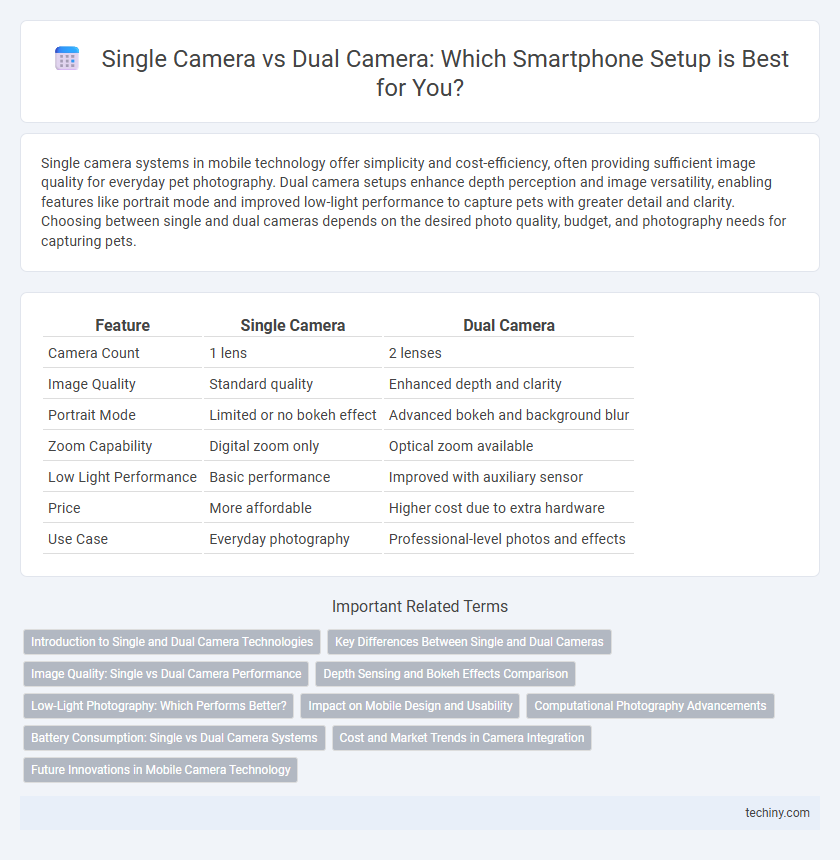Single camera systems in mobile technology offer simplicity and cost-efficiency, often providing sufficient image quality for everyday pet photography. Dual camera setups enhance depth perception and image versatility, enabling features like portrait mode and improved low-light performance to capture pets with greater detail and clarity. Choosing between single and dual cameras depends on the desired photo quality, budget, and photography needs for capturing pets.
Table of Comparison
| Feature | Single Camera | Dual Camera |
|---|---|---|
| Camera Count | 1 lens | 2 lenses |
| Image Quality | Standard quality | Enhanced depth and clarity |
| Portrait Mode | Limited or no bokeh effect | Advanced bokeh and background blur |
| Zoom Capability | Digital zoom only | Optical zoom available |
| Low Light Performance | Basic performance | Improved with auxiliary sensor |
| Price | More affordable | Higher cost due to extra hardware |
| Use Case | Everyday photography | Professional-level photos and effects |
Introduction to Single and Dual Camera Technologies
Single camera technology utilizes one sensor to capture images, relying on software algorithms to enhance photo quality and simulate depth effects. Dual camera systems incorporate two lenses with separate sensors, enabling advanced features such as optical zoom, improved low-light performance, and enhanced depth perception for portrait modes. The integration of dual cameras significantly advances mobile photography by providing more versatile image processing capabilities compared to single camera setups.
Key Differences Between Single and Dual Cameras
Single cameras use one lens and image sensor, offering simplicity and lower cost, while dual cameras combine two lenses to enhance photo quality through features like optical zoom, depth perception, and improved low-light performance. Dual camera setups enable advanced functionalities such as portrait mode with bokeh effects and wider dynamic range compared to single cameras. The integration of dual cameras enhances mobile photography by providing greater versatility in capturing diverse scenes and details.
Image Quality: Single vs Dual Camera Performance
Single camera systems often rely on high-resolution sensors and advanced software algorithms to enhance image quality, delivering sharp and detailed photos under various lighting conditions. Dual camera setups improve performance by combining two lenses, typically wide-angle and telephoto, enabling better depth perception, enhanced low-light capabilities, and improved dynamic range. The synergy of dual cameras results in more accurate color reproduction and superior portrait mode effects compared to single camera devices.
Depth Sensing and Bokeh Effects Comparison
Dual camera systems utilize a secondary lens specifically designed for depth sensing, enabling more accurate background blur and enhanced bokeh effects compared to single camera setups. By capturing two different perspectives, dual cameras generate detailed depth maps, resulting in superior subject isolation and professional-quality portrait photos. Single cameras rely on software algorithms to simulate bokeh, often producing less precise depth effects and limited background separation.
Low-Light Photography: Which Performs Better?
Dual camera systems typically outperform single cameras in low-light photography by combining multiple sensors to capture more light and detail, enhancing image clarity and color accuracy. Advanced features like optical image stabilization and larger aperture sizes in dual cameras improve performance in dim environments. Single cameras with advanced image processing software can produce decent low-light photos but often lack the depth and dynamic range achieved by dual-camera setups.
Impact on Mobile Design and Usability
Single camera setups simplify mobile device design, allowing thinner profiles and reduced manufacturing costs while maintaining ease of use for everyday photography. Dual camera systems enhance imaging capabilities with features like optical zoom and depth perception but require larger modules, which can increase device thickness and affect grip comfort. User experience improves through advanced photo modes, yet the added hardware complexity may challenge seamless integration into sleek smartphone designs.
Computational Photography Advancements
Single camera systems leverage advanced computational photography algorithms to enhance image quality by simulating depth and improving dynamic range through software processing. Dual camera setups enable simultaneous capture from multiple lenses, allowing for true optical zoom, improved low-light performance, and more accurate depth mapping for bokeh effects. Innovations in AI-driven image fusion and multi-frame noise reduction significantly advance both configurations, with dual cameras offering greater hardware versatility while single cameras rely heavily on sophisticated software enhancements.
Battery Consumption: Single vs Dual Camera Systems
Single camera systems consume less battery power compared to dual camera setups due to fewer sensors and reduced processing requirements. Dual camera systems demand higher energy to operate multiple lenses, image signal processors, and support features like depth sensing and optical zoom. Optimizing power management in dual cameras involves advanced software algorithms to balance image quality and battery efficiency.
Cost and Market Trends in Camera Integration
Single camera systems maintain lower production costs, making them prevalent in budget mobile devices, while dual camera setups increase expenses due to added sensors and image processing hardware. Market trends indicate a growing consumer demand for enhanced photography features, driving manufacturers to integrate dual or multi-camera modules in mid to high-end smartphones. This shift reflects an industry focus on advanced imaging capabilities, despite the higher cost and complexity associated with dual camera technology.
Future Innovations in Mobile Camera Technology
Single camera systems are evolving with advanced computational photography techniques, while dual camera setups enhance depth perception and low-light performance through sensor fusion. Emerging innovations like multi-sensor arrays and AI-powered imaging algorithms promise to revolutionize mobile photography by delivering superior image quality and augmented reality experiences. Future mobile camera technology will likely integrate novel sensor types such as LiDAR and time-of-flight to enable more precise environmental mapping and real-time 3D reconstruction.
Single Camera vs Dual Camera Infographic

 techiny.com
techiny.com